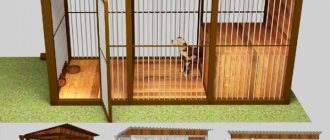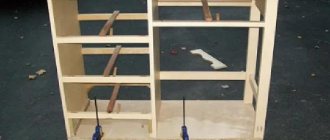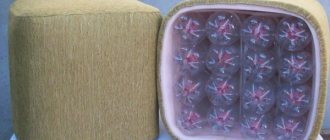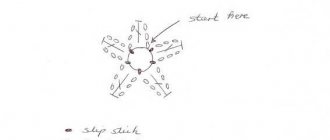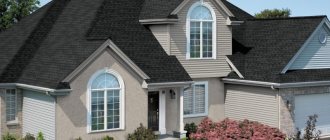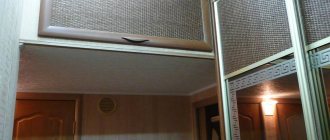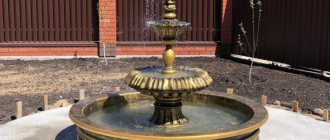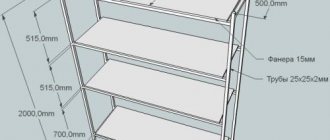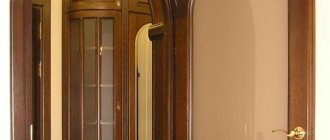Thermal insulation options
So, how to insulate a doghouse? Let's look at several options of varying complexity.
Felt
In terms of time and money, this option is the simplest and cheapest.
You can implement it yourself in just a couple of hours.
- Mats are cut out of thick felt according to the size of the walls, roof and floor. For cutting, use a regular sharp knife.
- They are fastened inside the booth with the roof removed using ordinary roofing nails with wide heads.
- The roof is installed in place.
What is the result? We get quite effective insulation that will not blow through the wind. The material is environmentally friendly and will not harm the health of our pet
What is equally important is that it has good vapor permeability: there will be no dampness in the booth
Mineral wool
Let's be honest: its use is rather dubious. The design will be quite complex; In addition, for the sake of high-quality insulation, the walls will have to be made very thick.
How to insulate a doghouse with mineral wool?
The instructions for thermal insulation work themselves are familiar to anyone who has ever insulated a loggia or balcony using this insulation:
- The walls are covered with a vapor barrier, which is secured with a stapler.
- A lath of 50x50 millimeters is placed on the walls around the perimeter of each.
- Mineral wool mats are cut to size with a knife and inserted into the sheathing, after which a second sheet of vapor barrier is stapled.
- The outside of the booth is covered with plywood, OSB or wooden clapboard along the sheathing.
Styrofoam
Compared to the previous insulation, foam plastic has several noticeable advantages:
- It provides the same effective thermal insulation with less thickness.
- Polystyrene foam does not cake and does not get wet (therefore it is often used to insulate balconies). Its thermal insulation qualities do not deteriorate over time.
How to insulate a dog's kennel for the winter with polystyrene foam? Minus unnecessary vapor barrier - exactly the same as mineral wool.
Along with homemade structures, you can find already insulated doghouses on sale. In most cases, they use foam plastic placed between two clapboard walls. Taking a look at such a product is quite educational.
Roll insulation
Let's be realistic: with an open manhole, thermal insulation will not have a very significant effect on the temperature in the booth. It is much wiser not to increase the thickness of the walls, but to reliably protect the dog from drafts.
In this case, you can get by with inexpensive roll insulation.
Foamed polyethylene provides reliable protection from wind and good thermal insulation even with a thickness of 4-6 millimeters. It is attached to the walls, floor and roof of the booth with the same stapler, after which it is again sheathed with any durable material. There is no need for lathing: short screws can be screwed directly through the insulation into the boards, as long as they do not stick out inside.
Penofol is an advanced version of rolled thermal insulation. Aluminum foil is applied to one side of the polyethylene foam, which reflects infrared radiation. Fixed between the inner and outer walls of the booth, the material will further reduce heat loss.
Do-it-yourself insulation of a dog house for the winter
Most often, it is necessary to insulate the yard dog’s apartment in the winter, when it is impossible to delay or postpone the insulation process for obvious reasons. A dog kennel, designed and constructed wisely, should be easy to disassemble. The roof, and sometimes the back wall of the booth, is usually made removable, so before you insulate it, you need to disassemble everything, thoroughly clean and dry it.
Bottom and floor covering
The most difficult thing is to insulate the bed or floor inside the kennel. Almost all dog breeds are extremely distrustful of replacing bedding and any attempts to insulate, change, or remake it. The dog can tear the insulation, throw it out of the kennel and defiantly lie down next to it. Therefore, the floor has to be insulated in two ways:
- A sheet of extruded polystyrene foam is placed under the bottom of the kennel, which is often used to insulate the walls and foundations of buildings for the winter. 50 mm thick EPS sheets are laid under the kennel, preferably in one piece, without seams or joints;
- Soft materials are laid on the floor, it can be an old woolen blanket, or a layer of sawdust can be added.
It is best if it is a thick mat with Velcro, which in winter can be easily taken out, cleaned of snow and accumulated debris and returned to its place. Therefore, owners often sew special mattresses with a top made of thick felt, an inner insert made of thick foam rubber and rubberized fabric at the bottom.
Be sure to place a film under the felt or sawdust
Wall insulation
For the vertical surfaces of the booth, it is best to use regular foam. If the dog lives on the street all the time, and it does not have the opportunity to hide in a summer kitchen or in an extension to the house, then it is best to insulate it with prefabricated slabs that can be easily pulled out if necessary.
In winter, with the onset of frost, you can easily remove the roof and lay foam plastic in the walls of the kennel. Typically, slabs are cut with tongues to avoid the appearance of cold bridges. At the end of winter, the insulation can be easily removed from the frame, thereby improving ventilation inside the booth.
Ceiling and roof
To insulate the upper part of the kennel, it is best to use rolled materials, such as polyethylene foam. The roof and ceiling most often suffer from condensation, so other materials cannot withstand moisture saturation and freezing. If the winter is severe enough, the roof can be further insulated by placing an old blanket or several compressed bales of hay on its surface.
How to insulate the entrance to a dog house
If the kennel is built according to all the rules, with an additional partition in front of the entrance, then there is no particular need to curtain the entrance to the kennel. Many dog owners play it safe, especially if the winter is harsh and frost can reach 25-30°C with strong winds.
An old blanket or jute will do, or in extreme cases, PVC film
Advice! In such conditions, it is better to give the dog the opportunity to spend the night in the hallway or utility room. A curtain at the entrance will not insulate the kennel, and the risk for the dog to get sick still exists.
The curtain or curtain at the entrance is usually made of very thick plastic film or rubberized tarpaulin. If you insulate a kennel, you need to be prepared for the fact that the curtain material may freeze to the wall. Therefore, for winter, the curtain is cut into strips:
- For small dogs, 4-5 vertical cuts are made, thick polyethylene will not freeze at the joints in winter, the animal can easily leave its kennel in any weather;
- For tall dogs, the curtain is slightly bent and cut with two side cuts. As a result, the curtain turns out to be quite rigid and does not flap in the wind, which is especially valuable for retaining heat in winter.
It is clear that the curtain will need to be changed periodically, so it is attached to the outside of the kennel facade. If it gets covered in snow in winter, the dog will always be able to push out the snow and fabric and get out of the kennel.
Does a dog freeze in a kennel in winter?
How does your pet spend the winter? Is the dog freezing in his kennel or is his fur enough to keep him warm? Of course, it freezes, especially if it is not a long-haired breed, and its home (kennel) also runs the risk of freezing, leaking, or being too ventilated. If your dog is truly a friend, then you need to treat it accordingly, that is, create the proper conditions for wintering.
First, you should check whether the booth is located in the right place or whether it should be moved to another:
- the entrance, if possible, should be located in a place where wind movement is minimal (calm);
- in rainy weather, water should not flow under the kennel, so it is necessary to insulate it or place the kennel on an elevated area;
- the kennel should not be located in the open sun, but excessive shade is not an option - you need to find a compromise;
- The dimensions of the booth must correspond to the size of the pet, i.e. it should not be cramped, but it should not be too spacious;
- Natural wood is considered the best material for a dog kennel.
The booth should be insulated in the same way as any other structure, taking into account all the nuances of insulation: proper protection from wind, frost and rain. Insulation can be done from the inside; this is appropriate to do when the structure can be disassembled and assembled or when there is sufficient internal space.
If the kennel is already ready and there is no way to disassemble the structure, you will have to carry out external insulation, then you should take care of the external finishing so that the kennel has a decent aesthetic appearance.
To be sure of the result of thermal insulation, it is necessary to insulate all surfaces of the booth: walls, roof and floor.
Our advice
Some owners prefer to let their dog indoors during very cold winter periods, and when the frost subsides, they send their four-legged friend back to the kennel. This is strictly forbidden, such a change in temperature is dangerous for the animal, it will certainly get sick. In cold regions, there is only one way out - a warm heated dog house.
If this is not possible, straw or sawdust is laid on the floor of the house. Under no circumstances should you place a rug, carpet or blanket, as all these fabrics absorb moisture.
If the dog is large and aggressive, it is not put on a chain, which it can break, but an enclosure is built around the booth. It also acts as additional insulation, especially if you make a solid wall of boards on the north or windy side.
Sometimes an insulated dog house (photo) is complemented by a porch with a canopy. Bowls with water and food are also placed here, which should be raised above the ground. The floor of the porch is also wooden. The canopy, like the roof frame, is often carved.
To make a dog house look aesthetically pleasing, it is painted or thematic drawings are made on the walls. Sometimes false windows are nailed in, or a ladder or railing is installed if the house is raised to a considerable height.
Is it necessary to insulate a dog house?
Dogs of different breeds tolerate low temperatures differently, but most of them cope well with the cold and are not even averse to sleeping in the snow. This especially applies to dogs of hunting breeds, since they have dense and thick hair.
But to understand whether a dog freezes in winter or not, taking into account only its breed is not enough. Dogs of the same breed tolerate cold differently because they are raised and live in different conditions.
Even the most cold-resistant animal, bred in an apartment or a warm house, will not be able to survive the winter outside normally.
In the Russian winter, the dog needs a warm kennel
The dog's body adapts to environmental conditions, which affects the condition and quality of the coat. Dogs kept in an apartment do not have undercoat, since they do not need it. If such a dog is released outside, especially in winter, it will be cold.
It is worth paying attention to the temperature that is set in the booth in winter. If the dog’s house is made of wood (the most common material), then the temperature in the box will differ by a maximum of 3–4 degrees from the ambient temperature
This is explained by the fact that air circulates freely through the outlet and does not allow heat to linger inside the dog house. Many owners hang a curtain over the exit hole for the winter, however, this is not a sufficient measure to create complete and comfortable winter conditions for the dog.
Do I need to insulate a doghouse for the winter?
Many owners of four-legged pets wonder whether the dog’s kennel is cold in winter. There is no definite answer to the question - it all depends on the climatic characteristics of the region and the breed of the dog.
Dog handlers agree that long-haired, wire-haired and short-haired dogs with thick undercoat can withstand frosts down to -40°C. Some breeds, such as Huskies, Leonbergs, Moscow Watchdogs and Bernese Mountain Dogs, prefer to sleep in the snow and stay outside even when it gets cold.
Warm home for a dog
However, whether a dog freezes in a kennel in winter depends not only on the breed, but also on the conditions in which the pet grew up. If he previously lived in an apartment, it will be difficult for him to spend the winter in a kennel without insulation. In a warm room, dogs shed more and lose their warming undercoat. It is necessary to adapt the animal's body to new living conditions gradually.
If the region is dominated by cold winters with long periods of sub-zero temperatures, then it is better not to risk the pet’s health and set up a warm dog house.
The need for thermal insulation of a dog house
Following a number of rules will help create an insulated kennel and reduce heat loss from the structure:
It is better to locate the entrance to the pet’s home in a place where the likelihood of drafts is minimal. It is advisable to use wood for the construction of walls - the material has low thermal conductivity. The dog house should not be placed on bare ground. The structure must be placed on bricks or wooden beams. The air gap will protect the bottom from freezing. A draft is worse than frost for dogs. Therefore, the hole must be curtained with a thick canopy. The material should be dense and weighted so as not to sway in the wind
It is important to maintain the optimal size. The dog can warm the compact booth with his breath
However, in a structure that is too cramped, the animal's movements will be limited.
Calculation of the optimal size of a dog kennel
It is necessary to prevent leaks in the winter hut - eliminate all cracks in the roof and take care of waterproofing the roof even before insulation.
DIY heated booth
If we are talking about cold regions or the dog is short-haired, heated housing is necessary. You can do it yourself.
A warm heated dog house differs in that the system includes an energy carrier. It comes in three types:
- panel;
- film;
- "warm floor".
The panel option is chosen in such a way that it covers one of the walls. The thickness of the plane is approximately 2 cm, screw it on using self-tapping screws. The electrical wire and switch are reliably insulated. It is best to place the cord in a metal pipe.
The temperature of the panel cannot exceed 50 degrees (otherwise the dog risks getting burned), so you should install a thermostat.
To prevent your pet from chewing on the insulation, a grille or metal box with multiple holes is screwed on top.
Film (roll) heaters operate on the basis of infrared radiation, they are considered the safest for dog housing, they are very thin, distribute energy evenly, but do not heat up themselves. They operate, like panels, silently and consume little electricity. But they also need to be protected from dog teeth with a metal frame.
If film and panel heaters are installed in ready-made booths, then it is better to install a “warm floor” during construction. To do this, a flat box is built at the bottom of the building according to the dimensions of the floor. An 80-watt heating wire and a thermostat are installed in it.
If the floor is to be made in a ready-made booth, the wire is pulled through the drilled holes. Then they need to be sealed with silicone sealant.
Let's warm ourselves up
In addition to the fact that the owner chooses the insulation option at his discretion, he must also think about how to cover the hole through which the lion's share of the heat escapes. To do this, you need to make a curtain from felt, tarpaulin or other dense protective fabric (even from an old thin rug). The curtain is attached using self-tapping screws and a wooden plank, and it is cut into equal strips so that the dog can walk inside the house. Some owners advise making an attached vestibule to the booth with their own hands, this way they can retain most of the heat inside the home.
You can lay hay or sawdust on the floor of the booth; this bedding is changed regularly. Someone lays rags or rugs on the floor, but remember that the animal does not always understand the purpose of the rug and can simply tear it apart. It is better to replace the rug with burlap or coarse cloth stretched over a wooden frame.
In addition, any insulation must be reliably protected from the inside of the booth. To do this, the interior of the booth is lined with clapboard, plywood, chipboard and OSB.
The video below will tell you how to make the floor of the booth warmer using ordinary hay!
Insulating a doghouse with felt
Let's consider in more detail the option of how to insulate the house of your four-legged guard with artificial felt.
- Roll of artificial felt.
- Sharp knife.
- Nails with wide heads.
Step-by-step instruction
Note that insulating the booth with felt yourself is the simplest and cheapest option. In addition, felt, as we have already noted, is considered safe for your pet and does not need to be “hidden” from the dog.
So, in order to insulate the booth with felt you need:
- Cut the felt into pieces equal in size to the walls using a sharp utility knife.
- Attach the felt pieces to the walls using nails with wide heads. You can also sheath the inside of the roof and floor.
- Felt does not have to be sheathed on top with wood or plywood. By the way, felt protects well from wind and moisture.
Don't forget to lay a warm rug on the floor!
Insulation with mineral wool
Insulating a booth with mineral wool with your own hands is a more labor-intensive process than the previous option. However, it should theoretically provide higher thermal insulation if done correctly.
- Mineral wool;
- Wooden blocks;
- Knife, nails, stapler;
- Vapor barrier;
- Plywood, chipboard or OSB.
Step-by-step instruction
- First, the roof of the booth is removed, and its walls are covered with a vapor barrier, which is secured with a stapler.
- Next, all the walls are covered with a sheathing of beams.
- Using a knife, “mats” of cotton wool are cut to the size of the sheathing and placed in it.
- Next, the cotton wool is again covered with a layer of vapor barrier.
- This entire “sandwich” is tightly sheathed on top with wood, plywood, chipboard or OSB so that the dog cannot disturb the insulating structure.
As a result, the walls insulated with mineral wool turn out to be quite thick. Using a similar principle, you can make insulation with polystyrene foam. A rug on the floor will make your home more comfortable.
Hay and straw
If your four-legged friend lives in outdoor conditions, then it is highly undesirable for him to use hay or straw as bedding. There is a high chance that your pet will become infected with parasites such as fleas and ticks. In addition, all organic litter is characterized by the presence of enterobacteria: intestinal bacteria, salmonella. Also in straw and hay there are intestinal eels, which cause a wide variety of diseases in dogs. Another significant disadvantage of these materials is that they cannot be disinfected.
However, despite all the dangers and warnings, many owners like to use hay and straw as bedding. They motivate this by the fact that these materials are environmentally friendly, have a pleasant smell and retain heat well.
To prepare hay for bedding, care must be taken not to overdry it. It must be shaken periodically to prevent the hay from becoming rotten. To prevent infection by parasites, it is necessary to regularly, every week, make new bedding with the addition of herbs that have antiparasitic properties: thyme, sage, wormwood. The litter must be shaken every day.
To prepare straw bedding, it is best to use plants with a rigid stem (rye, wheat, reeds). Oat straw is definitely not suitable for this purpose, as it tends to crumble very much.
How to make a warm dog house, drawings, photos
Do-it-yourself insulated permanent dog house: drawings and dimensions. Step-by-step photo instructions for making a doghouse from boards and insulation.
google_ad_client = "ca-pub-1974473278197966"; google_ad_slot = "3501064932"; google_ad_width = 580; google_ad_height = 400; ">
First, you need to decide on the size of the booth, which in turn depends on the size of the pet. The booth should not be large, because the dog will not be able to warm up well in a large kennel; the optimal size of the internal space of the booth should be such that the dog can freely turn around in the booth; the height of the booth is equal to the height of the dog with its head raised.
Optimal kennel sizes for certain types of dogs.
To make an insulated booth you will need timber, boards and insulation. Foam or mineral wool can be used as insulation. You can use nails to fasten the boards, but self-tapping screws are more reliable.
Step-by-step production of a warm dog house: drawings, diagram, photo.
Let's look at the process of making a booth step by step with drawings.
1.STEP. Let's make the base for the booth.
2.STEP. Niche for insulation.
We will need timber with a cross section of 50 x 50 mm. We saw it into bars, two bars of 90 cm and two of 60 cm. We attach the bars to the base.
3.STEP. Laying insulation.
4. STEP. Booth floor.
We will need boards 90 cm long, we cover the insulation with boards, and fasten the boards with self-tapping screws to the timber.
5. STEP. Side walls of the booth.
Now we need to make two side walls, we use boards 65 cm long and bars 40 cm long. We fasten the walls to the floor using metal corners and self-tapping screws; alternatively, you can first fasten a horizontal bar at the bottom of each wall, then screw the bars with screws to the floor , distance between walls 70 cm.
6. STEP. Front and back walls of the booth.
7. STEP. We fasten all the walls of the booth together with self-tapping screws.
8. STEP. We put insulation on the walls of the booth (don’t forget about the vapor barrier for mineral wool).
9. STEP. We cover the walls of the booth with boards.
10. STEP. The roof of the booth. We fasten the roof boards to the walls.
11. STEP. We fasten the bars under the insulation.
12. STEP. We install insulation.
14. STEP. We cover the roof insulation with boards.
Where is the best place to install a dog house?
The booth should be installed in the yard of the house in such a way that the dog has a good view of the yard and the entrance gate, but at the same time, during scorching heat, the booth should be in the shade of buildings, a fence or a tree. In winter, do not forget about the dog’s bedding; the kennel should be half filled with hay or straw to make it easier for the dog to stay warm.
«>
Drawing of an insulated booth and selection of materials
Before you begin drawing the future structure, you should collect the required minimum of working tools. These are:
- saw;
- screwdriver or hand drill;
- self-tapping screws;
- corners;
- level and tape measure;
- sealant;
- brushes and paint;
- drill.
Then you need to decide what material to make the kennel from. It is better not to use plastic, brick, synthetic elements. Preference is given to wood. These can be boards, lining, plywood. Important points:
The insulated dog house should not stand on the ground, it should be raised using cinder blocks or placed on a platform;
It is necessary to decide in advance what kind of insulated booth to make: one-room, two-room or with a vestibule.
Now they begin to carry out the drawing. For example, let’s take the option with a large vestibule and a pitched roof. Such a project has two advantages:
In the summer, the dog will use the vestibule, and in the winter, the insulated room.
Water will drain from a pitched roof after rain, and in the hot summer a dog can lie on it.
Kennel insulation technology
Floor and bottom
- You need to start work with insulating the floor and protecting the bottom. To do this, you need to turn the structure upside down. Treat the surface with protective agents against material destruction and cover with roofing felt (can be secured with bars). This provides external protection for the floor.
- Turn the booth over and continue insulating the floor. Cover the floor with insulating film, it can be the same roofing felt or glassine. To avoid gaps, it is better to lay it overlapping and shoot it with a construction stapler, and also, it’s good, to put film on the walls.
- Next comes a layer of insulation that needs to be covered. If the insulation is bulky or too soft, it is better to fill in bars (such as joists) for installing the finished floor.
- Laying the finished floor. To do this, you can use a regular (pre-treated) board or boards (plywood, OSB).
- To prevent the booth floors from freezing and leaking, it is recommended to do additional insulation work. At the site where the booth is installed, according to its dimensions, it is necessary to make a shallow excavation (up to 20 cm), fill it with gravel or expanded clay, and cover it with an insulating film (roofing felt), which should come to the surface. For external insulation, it is hemmed under the cladding. If you install the booth on a similar base, this will minimize freezing of the floor and protect it from water.
Walls
The walls are insulated according to the standard scheme for each insulation. Step by step it looks like this:
- wall treatment;
- waterproofing (if necessary);
- fastening (installation) of insulation;
- vapor barrier (if necessary);
- wall decoration (when using certain insulation materials).
The main condition when insulating the walls of a doghouse is to prevent the space from being blown through and water from getting inside it.
Roof and ceiling
The roof-ceiling in one design is suitable for a kennel located in an enclosure with a canopy, where leakage is almost impossible, otherwise, it is better to make a pitched roof for the kennel, and it must be removable.
We insulate the so-called “attic” of the roof in the same way as the floor. First we fix the insulating film on it, then the insulation. When the roof is insulated, the dog will not have access to it, so there is no need to close it.
It is also better to protect the internal slopes of the roof from wind and moisture; to do this, you need to line them around the perimeter with insulation or insulating material.
Kennel dimensions
A kennel that is too spacious does not retain heat well, and a dog will not feel comfortable in a small kennel.
When calculating sizes, you should adhere to the following principles:
- The height of the dog house should be equal to the sum of the height of the animal at the withers, the thickness of the bedding and an additional 10-15 centimeters. Your pet should move around inside the kennel with its head bowed, and lie down and sit without touching the top of its head to the ceiling.
- The optimal length and width of the structure will allow even a large dog to lie on the floor with its paws extended.
- The width of the vestibule must be sufficient for the free movement of the animal. The vestibule can be designed to be as spacious as the main room, so that on warm days the dog can lie in it on its side with its paws extended.
- The size of the entrance to the kennel (manhole) may be slightly less than the height of the dog at the withers (by 5 cm). The width of the opening should allow the dog to freely enter and exit the kennel. The optimal solution would be to add 5-8 centimeters to the width of the animal’s chest.
A way to insulate a dog house with mineral wool
Often a doghouse is insulated with mineral wool. But this option has certain difficulties. Mineral wool retains heat better. Among the materials for work you will need mineral wool, plywood, a vapor barrier and wooden beams. You should stock up on tools with a stapler and nails.
Stages of insulation with mineral wool:
- First, the roof of the booth is disassembled. Then they lay the vapor barrier on the walls using a stapler.
- Then the walls are lathed with beams.
- Mineral wool is mounted on the sheathing. You should measure and cut out the necessary pieces in advance. Mineral wool is carefully placed between the beams.
- A vapor barrier is laid on the mineral wool.
- The final stage will be covering the internal surfaces with plywood.
Insulation for booths thickens the walls in the booth. Because of this, the area of the home is reduced. For greater dog comfort, you can create warm floors by laying a bedding or rug.
How to insulate a dog house using electricity
You can make an insulated booth for an alabai with your own hands using a heater using one of the options:
- Using a metal panel with a width of 2 cm. It is recommended to install it using self-tapping screws, mounting it to one of the walls of the booth. The temperature inside with this option can reach 50 °C. Taking into account the recommendations of professionals, the heater should be placed under the interior decoration. To avoid accidental fire, it is not recommended to turn on the device at full power. There is no need to use a mat here for even greater insulation. The use of an electric heater allows you to achieve a comfortable temperature for your dog to stay in winter.
- Film solution. Its principle is the same as that of infrared radiation. When installing such a device, the temperature can be almost 60 °C. Thanks to its thin design, it can be mounted under the internal cladding. The advantage of heating using infrared rays is the generation of natural heat, which is the same as that of the animal. Alternatively, this device can easily be placed on the floor under a rug. A warm floor in a booth is the key to your pet’s health.
The best way to insulate a dog house - step by step instructions
Don't want your dog to freeze in winter, but have nowhere to buy a suitable kennel? You can make a pet’s house comfortable at home. How and what is the best way to insulate a dog house with your own hands.
When should you insulate a booth?
An uninsulated dog house can protect against wind, rain and direct sunlight, but not against cold. Insulation is recommended for:
- all dogs living outside during the cold season;
- puppies and older pets, as well as dogs in poor health year-round.
Insulation can be “built on” to an existing kennel or done during the construction of a dog house.
Required tools and materials
To insulate the booth, you will need the following:
- rescue blanket;
- vapor barrier film;
- rigid polymer thermal insulation;
- bubble wrap;
- insulation for walls;
- wall panels;
- plywood;
- carpet covering;
- wooden pallets.
It is also recommended to install a transparent plastic door and pour hay inside the booth - the dog will make a cozy “nest” in it, and it will be even warmer. Don't use batting - it's ineffective when wet and can harbor rodents.
In order to insulate the floor, you must perform the following steps:
- Place a vapor barrier and a safety blanket between the doghouse and the ground (or concrete) it sits on. This layer prevents the entry of dampness and cold air, as well as heat loss. Replace the layer when it tears or becomes moldy.
- Create a platform under the booth. A wooden pallet topped with a sheet of plywood will raise the dog house above wet or cold ground. The bottom and sides of the pallet are covered with foam or bubble wrap.
- Make a half sandwich. Additional layers of plywood sheets covered with insulation are placed inside the booth (if it is spacious) or outside (if it is small).
To insulate the roof:
- Make thermal insulation. Use foil, plastic or bubble wrap. These materials are easy to cut and attach to the inside of the roof, and cover the top with panels.
- Strengthen the roof. Install rigid polymer insulation and insulate it with panels or plywood.
- Reduce heat loss. Cover the outside of the roof with tarps or wall insulation. In summer, this layer must be removed for natural ventilation of the booth.
For walls:
- Make sandwich walls. The steps are the same as when creating a “sandwich” floor, but additional panels are installed on top.
- Hang carpeting. Attach hooks to the walls of the booth and hang pieces of carpet on them. Do not use this method in areas with high humidity!
- Provide heat and moisture insulation. A tarpaulin or other protective woven synthetic material that does not allow water to pass through is suitable for this.
https://.com/watch?v=lfs5vNeKyEA
Be careful to ensure that your dog doesn’t start chewing and eating insulation – this can lead to serious health problems. Plywood and wall panels are needed to prevent the animal from reaching the more dangerous (and chewable) inner layers. An additional budget method of insulation is to move the booth to the veranda from the ground or concrete.
- elatka
Heating a dog kennel
With the advent of modern safe heaters, many owners are trying not only to insulate, but also to install heated kennels. This solution will be successful for dogs living in the country and outside the city, where a sharp cold snap in winter can turn into a tragedy.
Heated kennels are placed either on the floor or on the ceiling
A good option is a homemade heater made of cable or graphite film, installed on the ceiling of the booth. It is clear that heating does not solve all problems; it is still necessary to insulate the kennel, but for purebred dogs that are not particularly healthy, the presence of cable heating of the ceiling or floor can be extremely important in order to survive the winter.
It is best to use a self-regulating two-core heating cable. In winter, in the coldest weather, it easily produces up to 200 W from every ten meters of wire laid inside the booth. This is enough to insulate and heat the kennel to above-zero temperatures.
